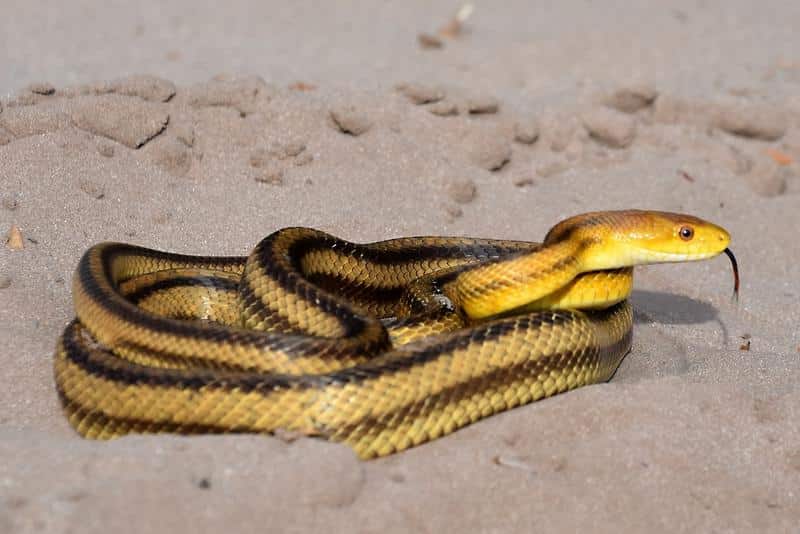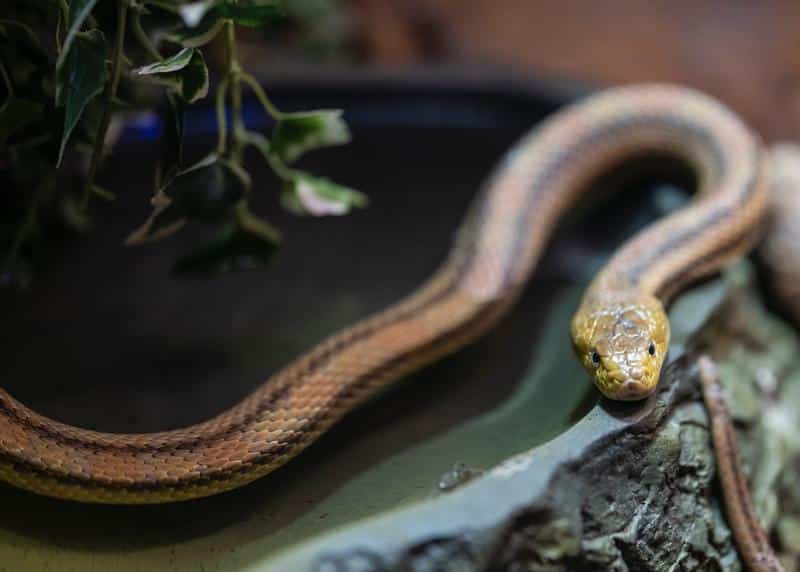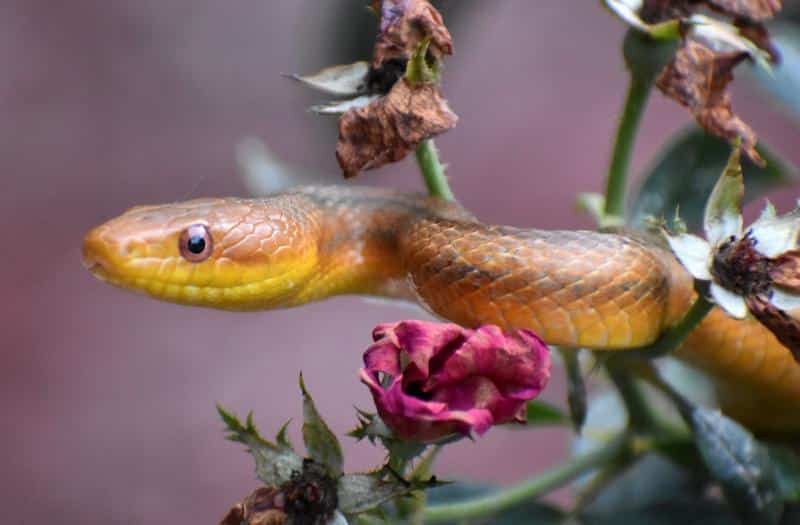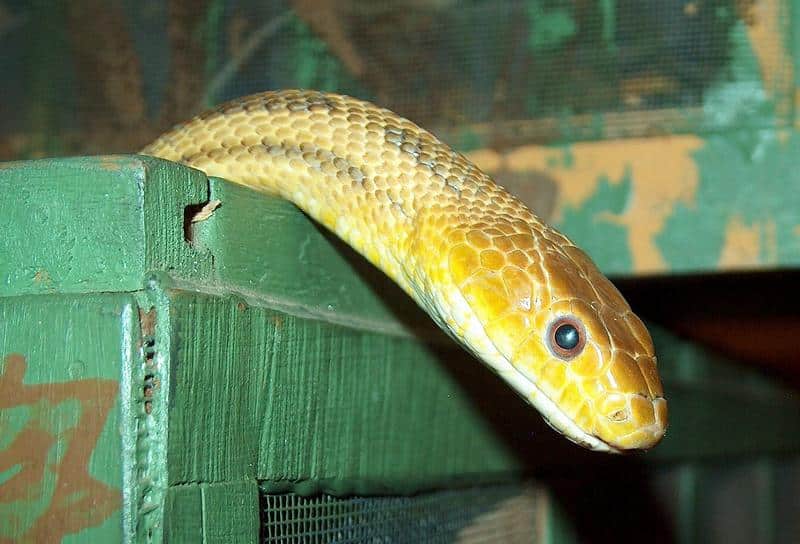Are Rat Snakes Poisonous to Dogs? What to Do if Rat Snake Bites Dog!
Are rat snakes poisonous to dogs? In this article, we’ll tell you what to do if a rat snake bites your dog and teach you the easy command that will keep your dog safe in future encounters.
We’ll then answer questions like are rat snakes dangerous, can a rat snake kill a dog, what do rat snakes look like, where do they hide, and more.
Finally, we’ll help you keep your home and backyard safe for your dog by instructing you on how to get rid of rat snakes naturally. Keep reading!
Are Rat Snakes Poisonous to Dogs?

Rat snakes are not poisonous to dogs. However, any interaction between a snake and a dog can be potentially dangerous due to the risk of physical harm or disease transmission. Hence, the best course of action is to train your dog to avoid snakes, reducing the chances of harmful encounters.
Are Rat Snakes Dangerous to Dogs?
While rat snakes are not poisonous, they can still be dangerous to dogs. Rat snakes are constrictor snakes, meaning they will coil around their prey to suffocate them. However, they usually reserve this behavior for their meals. If a rat snake feels threatened by a dog, it might strike out defensively, which can cause injury, even though they do not inject venom.
The potential harm isn’t limited to physical injuries alone. Snakes, including rat snakes, can carry parasites like ticks or mites, or have bacteria in their mouths, which can lead to infections if a dog is bitten. Also, if a dog kills and eats a rat snake, it can risk ingesting any parasites the snake was carrying, leading to potential health issues.
Are Rat Snakes Venomous?
Rat snakes are not venomous. They belong to the Colubridae family, a group of snakes known for being generally harmless to humans and larger mammals like dogs. They use constriction to subdue their prey, usually rodents, birds, and eggs.
This lack of venom makes them less dangerous than other types of snakes, but it does not mean they are entirely safe for dogs to interact with.
Train the “Leave It” Command
To ensure your dog’s safety around snakes, including rat snakes, it’s helpful to teach the “leave it” command. This command instructs your dog to immediately stop what it’s doing, be it sniffing, eating, or approaching something—like a snake. Here’s a brief guide on how to train the “leave it” command:
- Hold a treat in both hands. Present one hand to your dog, and say “leave it.”
- Your dog will likely try to get the treat. Keep your hand closed and ignore the behaviors.
- Once your dog stops trying and pulls away, say “good” or “yes,” then give them the treat from the other hand.
- Repeat this exercise until your dog moves away from the first hand when you say “leave it.”
- Now you can practice with different items, gradually moving to objects on the ground and eventually practicing in various environments.
Remember, it’s always best to avoid encounters between your dog and any kind of snake. Training, supervision, and understanding snake behaviors can all contribute to your dog’s safety.
But while these steps will get your dog to stay away from rat snakes, the underlying behavioral issues (prey drive, aggression, dominance, etc.) that were causing all of this to begin with will still be present. And until you address those, any positive changes you see are only going to be temporary.
“Well, how do I make these changes last?”
By getting your dog to truly choose to follow your direction, that’s how. I tried many times to write out how you can do that before deciding it made more sense to just link you to the free video series that explains it better than I’d ever be able to.
The series is by a man named Dan who is one of the world’s leading dog obedience trainers. In it, he teaches you how to put an end to things like your dog bothering rat snakes and all other misbehavior using his fast and easy-to-follow methods.
In the first video, Dan will reveal to you why the two most common methods of dog training only doom you to failure. You can watch the video now by clicking here. Follow the proven system he’ll show you in his series and you’ll never have to spend another second worrying about your dog getting too close to rat snakes ever again!
Rat Snake Bites Dog

Rat snakes can bite dogs if they feel threatened, but these bites are generally not lethal due to the non-venomous nature of rat snakes. Immediate veterinary care should be sought for any snake bite to prevent infection and ensure your dog’s well-being.
Do Rat Snakes Bite Dogs?
Rat snakes do bite dogs. Like any other creature, they will defend themselves if they feel threatened. If a dog disturbs a rat snake, the snake may choose to strike in self-defense, resulting in a bite. However, rat snakes do not actively seek out encounters with dogs and will typically try to escape if possible.
Can a Rat Snake Kill a Dog?
It’s highly unlikely for a rat snake to kill a dog. Rat snakes are constrictors and non-venomous. While they can subdue small prey like rodents and birds through constriction, this tactic would generally be ineffective against a larger animal like a dog. However, a bite from a rat snake could lead to other complications, like infection, especially if not treated promptly.
Are Rat Snakes Aggressive?
Rat snakes are not aggressive. They prefer to avoid confrontation and will often flee if given the opportunity. However, like most animals, they can become defensive if cornered or provoked. Aggression in rat snakes, as expressed by biting or lunging, is usually a last resort when escape is not possible.
Rat Snake Dog Bite Symptoms
A dog bitten by a rat snake may exhibit certain symptoms, though these will generally be less severe than bites from a venomous snake. Signs that a dog may have been bitten by a rat snake include:
- Local swelling and redness around the bite area
- Signs of pain such as whimpering or limping
- Possible puncture wounds
- Behavioral changes such as restlessness or aggression due to discomfort
Even though rat snakes are not venomous, you still need to seek veterinary care immediately following any snake bite. A bite can lead to secondary infection if not properly cleaned and treated, and your vet can provide appropriate care and guidance for your dog’s recovery.
Learn the command you’ll need to keep your dog safe in the future by going back to the first section.
You need to get this taken care of now, as it will also make your dog safe during other potential meetings. You will then not have to worry about things like king snakes being dangerous to dogs, milk snakes being poisonous to dogs, corn snakes being poisonous to dogs, copperheads biting your dog, black snakes biting your dog, or garter snakes biting your dog because you’ll know your pup will behave and keep away.
What Do Rat Snakes Look Like?

Rat snakes are medium-to-large constrictors with smooth scales and a range of color patterns, often reflecting their specific subspecies and region. They typically have a pointed head, round pupils, and a robust body that can grow up to 4-6 feet long.
Where Do Rat Snakes Live?
Rat snakes are incredibly adaptable and inhabit a wide range of environments across the United States. They are found in forests, fields, farmland, and even suburban neighborhoods. Depending on their subspecies, they can be located from the East Coast to the central United States.
Rat snakes often live in trees, but they can also be found in abandoned buildings, farmyards, and low-lying scrub.
When Are Rat Snakes Most Active?
Rat snakes are diurnal, which means they are most active during the day. However, in hot weather, they may switch to a more nocturnal schedule to avoid extreme temperatures. They’re active mainly in the spring and fall as they hibernate during the winter. They are also highly active during their breeding season, which typically occurs in the spring.
Where Do Rat Snakes Hide?
Rat snakes are known for their climbing ability and can often be found hiding in trees. They will also hide under rocks, logs, or within dense vegetation. They may seek shelter in abandoned buildings, barns, and sheds, especially if there is a readily available food source, such as a rodent population. During winter months, rat snakes hibernate in rock crevices, burrows, or inside trees.
By understanding what rat snakes look like and their habits, you can better protect your pets and create a safer environment in areas where these snakes are common. Learn the command you’ll need to keep your dog safe around these snakes by going back to the first section.
How to Get Rid of Rat Snakes Naturally

You can naturally discourage rat snakes from your property through habitat modification, natural repellents, and the use of physical barriers. The key is to make your space less appealing to these creatures, ensuring their safe removal without causing them harm.
- Habitat Modification: Rat snakes are drawn to environments that offer shelter and a rich food supply. By eliminating possible hiding spots and controlling their food source, you can make your yard less enticing. This can involve maintaining your grass at a short length, removing debris or wood piles, and sealing spaces beneath structures like decks and porches. Also, keep your rodent population in check since rat snakes are particularly attracted to places with plenty of rats and mice for them to prey on.
- Natural Repellents: There are natural substances known to repel rat snakes. A mixture of essential oils such as cinnamon and clove oils can work as a deterrent when mixed with water and sprayed around your property. However, the efficiency of such natural repellents can vary, and you may need to reapply them regularly, particularly after heavy rainfall.
- Physical Barriers: Physical barriers can prevent rat snakes from entering your yard. Install a fine mesh or solid fence around the perimeter of your property. Make sure the fence is buried several inches into the ground to stop snakes from burrowing underneath. Moreover, cover any gaps or holes in your house’s foundation, as snakes can squeeze through surprisingly small spaces.
While rat snakes play a crucial role in controlling rodent populations, they are not always welcome guests. By using habitat modification, natural repellents, and physical barriers, you can effectively discourage rat snakes from your property without harming them, ensuring a safe and snake-free environment for both you and your dog.
Learn the command your dog should know to stay safe around rat snakes by going back to the first section of this article.
Now that you know what to do if a rat snake bites your dog (and better yet, how to keep them away), you probably feel much better. Good luck with everything, and thanks for reading our article “Are Rat Snakes Poisonous to Dogs? What to Do if Rat Snake Bites Dog!”





